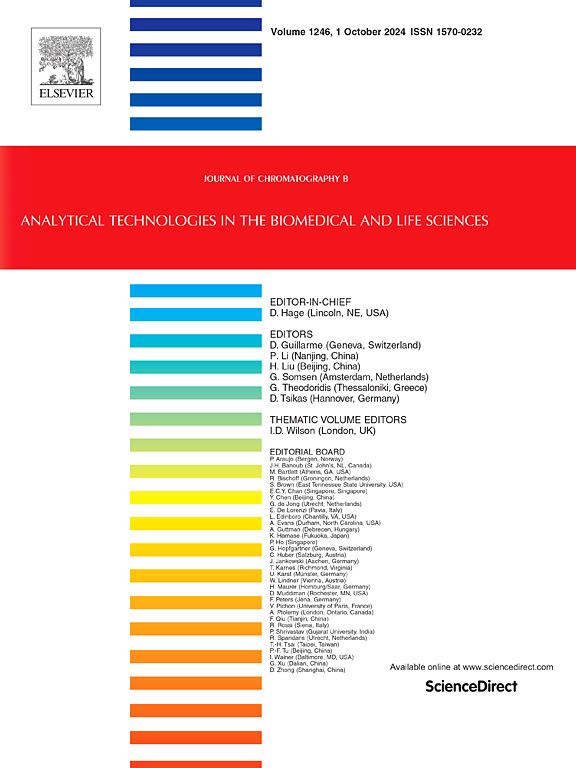基于hilic - fld的孕妇血浆n -糖基化谱表征作为胎儿和新生儿溶血性疾病的新型诊断和预测生物标志物
IF 2.8
3区 医学
Q2 BIOCHEMICAL RESEARCH METHODS
引用次数: 0
摘要
ABO血型不相容所致的胎儿和新生儿溶血病(hddn)缺乏有效的预防措施,需要先进的产前早期预测策略。本研究探讨了妊娠相关的母体血浆n糖改变是否能够准确预测和诊断abo介导的HDFN。我们在一个发现队列(40例hdn病例与匹配对照组)中使用亲水相互作用液相色谱与荧光检测(HILIC-FLD)进行了超高分辨率血浆n糖组学。通过色谱聚糖峰的逻辑回归(LglycoP)和糖基化性状的特征水平分析(LglycoF)建立糖基化预测模型。模型的性能在一个独立的队列(n = 42)中进行验证,使用接收算子曲线下面积(AUC-ROC)和自举重采样进行稳定性评估。在HDFN妊娠中发现了显著的n -糖调节失调,有5个区别性的聚糖峰和糖基化模式的改变,其特征是糖基化的分支化、三烷基化、二烷基化和三半乳糖化。LglycoP模型在发现和验证队列中都显示出强大的预测和诊断能力(AUC >;分别为0.80)。本研究建立了母体血浆n -糖糖谱分析作为abo - hdn早期预测和诊断的精确工具,特别是在抗体滴度测试的临床假阳性类别中。在abo - hhdn妊娠中发现独特的血浆n -糖蛋白失调特征,表明母体糖炎症反应与胎儿红细胞活化之间存在潜在的机制联系,为abo - hhdn发病机制提供了新的视角。本文章由计算机程序翻译,如有差异,请以英文原文为准。
HILIC-FLD-based characterization of maternal plasma N-glycosylation profiles as novel diagnostic and predictive biomarkers for hemolytic disease of the fetus and newborn
ABO incompatibility-induced hemolytic disease of the fetus and newborn (HDFN) lacks effective preventive measures, necessitating advanced strategies for early prenatal prediction. This study investigated whether pregnancy-associated maternal plasma N-glycome alterations enable accurate prediction and diagnosis of ABO-mediated HDFN. We conducted ultra high-resolution plasma N-glycomics using hydrophilic interaction liquid chromatography with fluorescence detection (HILIC-FLD) in a discovery cohort (40 HDFN cases vs. matched controls). Glycomic predictive models were developed through logistic regression of chromatographic glycan peaks (LglycoP) and feature-level analysis of glycosylation traits (LglycoF). Model performance was validated in an independent cohort (n = 42) using area under the receiver operator curve (AUC-ROC) with bootstrap resampling for stability assessment. Significant N-glycome dysregulation was identified in HDFN pregnancies, with 5 discriminative glycan peaks and altered glycosylation patterns featured by branching, trisialylation, di- and tri-galactosylation of glycans. The LglycoP model demonstrated robust capability of prediction and diagnosis of in both the discovery and validation cohort (AUC > 0.80), respectively. This study establishes maternal plasma N-glycomic profiling as a precision tool for early prediction and diagnosis of ABO-HDFN, particularly for clinical false positive category of antibody titer test. Identification of unique plasma dysregulation of N-glycome features in ABO-HDFN pregnancies suggest potential mechanistic links between maternal glyco-inflammatory responses and fetal erythrocyte opsonization, offering new perspectives on ABO-HDFN pathogenesis.
求助全文
通过发布文献求助,成功后即可免费获取论文全文。
去求助
来源期刊

Journal of Chromatography B
医学-分析化学
CiteScore
5.60
自引率
3.30%
发文量
306
审稿时长
44 days
期刊介绍:
The Journal of Chromatography B publishes papers on developments in separation science relevant to biology and biomedical research including both fundamental advances and applications. Analytical techniques which may be considered include the various facets of chromatography, electrophoresis and related methods, affinity and immunoaffinity-based methodologies, hyphenated and other multi-dimensional techniques, and microanalytical approaches. The journal also considers articles reporting developments in sample preparation, detection techniques including mass spectrometry, and data handling and analysis.
Developments related to preparative separations for the isolation and purification of components of biological systems may be published, including chromatographic and electrophoretic methods, affinity separations, field flow fractionation and other preparative approaches.
Applications to the analysis of biological systems and samples will be considered when the analytical science contains a significant element of novelty, e.g. a new approach to the separation of a compound, novel combination of analytical techniques, or significantly improved analytical performance.
 求助内容:
求助内容: 应助结果提醒方式:
应助结果提醒方式:


